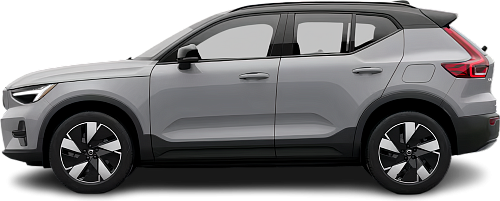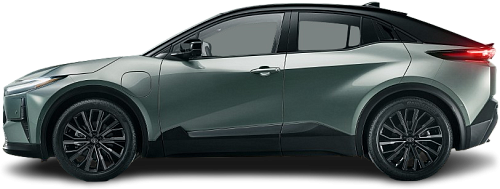Global EV Comparison: Volvo XC40 Recharge (EX40) Pure Electric vs Toyota C-HR+ 57.7 kWh FWD
Struggling to Decide? Let AI Help!
Your AI Summary Is Ready!
General Info
Although the Toyota C-HR+ 57.7 kWh FWD (2025-…) has been announced, it is not yet in production and will not be available for sale in Europe. The Volvo XC40 Recharge (EX40) Pure Electric (2022) has been discontinued. You can find it for as low as €30890 on the used car market.
The two vehicles share the same body style: SUV.
| Property | Volvo XC40 Recharge (EX40) Pure Electric | Toyota C-HR+ 57.7 kWh FWD |
|---|---|---|
| Years of Production | 2022-2022 | 2025-… |
| Current Status | Discontinued | Announced |
| Country of Manufacture | Belgium | Japan, China |
| Body Style | SUV | SUV |
| Market Availability | EU | EU, USA |
| Price Europe (Used) | €30890 | - Price Europe (Used) |
| GCC Score | 6.1 | 6 |
Range and Efficiency
Even though the Volvo XC40 Recharge (EX40) Pure Electric (2022) has a larger battery, the Toyota C-HR+ 57.7 kWh FWD (2025-…) higher energy efficiency results in a longer real-world driving range.
| Property | Volvo XC40 Recharge (EX40) Pure Electric | Toyota C-HR+ 57.7 kWh FWD |
|---|---|---|
| Range (WLTP) | 425 km | 455 km |
| Range (GCC) | 366 km | 387 km |
| Battery Capacity (Nominal) | 69 kWh | 57.7 kWh |
| Battery Capacity (Usable) | 67 kWh | 51.9 kWh |
| Efficiency per 100 km | 18.3 kWh/100 km | 13.4 kWh/100 km |
| Efficiency per kWh | 5.46 km/kWh | 7.46 km/kWh |
| Range and Efficiency Score | 6.3 | 8.2 |
Charging
Both vehicles utilize a standard 400-volt architecture.
Both vehicles support DC fast charging with a maximum power of 150 kW.
Both vehicles are equipped with the same on-board charger, supporting a maximum AC charging power of 11 kW.
| Property | Volvo XC40 Recharge (EX40) Pure Electric | Toyota C-HR+ 57.7 kWh FWD |
|---|---|---|
| Max Charging Power (AC) | 11 kW | 11 kW |
| Max Charging Power (DC) | 150 kW | 150 kW |
| Architecture | 400 V | 400 V |
| Charge Port | CCS Type 2 | CCS Type 2 |
| Charging Score | 6.2 | 6 |
Performance
Both vehicles are front-wheel drive.
The Volvo XC40 Recharge (EX40) Pure Electric (2022) boasts greater motor power and accelerates faster from 0 to 100 km/h.
| Property | Volvo XC40 Recharge (EX40) Pure Electric | Toyota C-HR+ 57.7 kWh FWD |
|---|---|---|
| Drive Type | FWD | FWD |
| Motor Type | PMSM | PMSM |
| Motor Power (kW) | 170 kW | 123 kW |
| Motor Power (hp) | 228 hp | 165 hp |
| Motor Torque | 330 Nm | 228 Nm |
| 0-100 km/h | 7.4 s | 8.6 s |
| Top Speed | 160 km/h | 160 km/h |
| Performance Score | 3.6 | 3 |
Dimensions
The Toyota C-HR+ 57.7 kWh FWD (2025-…) has a longer body, while the Volvo XC40 Recharge (EX40) Pure Electric (2022) stands taller, offering a more elevated ride. Their widths are almost identical, so both offer a similar amount of shoulder room.
Both models have similar wheelbase lengths.
| Property | Volvo XC40 Recharge (EX40) Pure Electric | Toyota C-HR+ 57.7 kWh FWD |
|---|---|---|
| Length | 4425 mm | 4520 mm |
| Width (with Mirrors) | 2034 mm | - Width (with Mirrors) |
| Width (w/o Mirrors) | 1873 mm | 1870 mm |
| Height | 1652 mm | 1595 mm |
| Wheelbase | 2702 mm | 2750 mm |
Cargo and Towing
A frunk (front trunk) is available in the Volvo XC40 Recharge (EX40) Pure Electric (2022), but the Toyota C-HR+ 57.7 kWh FWD (2025-…) doesn’t have one.
The Volvo XC40 Recharge (EX40) Pure Electric (2022) is better suited for heavy loads, offering a greater towing capacity than the Toyota C-HR+ 57.7 kWh FWD (2025-…).
| Property | Volvo XC40 Recharge (EX40) Pure Electric | Toyota C-HR+ 57.7 kWh FWD |
|---|---|---|
| Number of Seats | 5 | 5 |
| Curb Weight | 2030 kg | - Curb Weight |
| Cargo Volume (Trunk) | 410 l | 416 l |
| Cargo Volume (Max) | 1295 l | - Cargo Volume (Max) |
| Cargo Volume (Frunk) | 31 l | - Cargo Volume (Frunk) |
| Towing Capacity | 1500 kg | 750 kg |
| Cargo and Towing Score | 6.7 | 6.3 |




